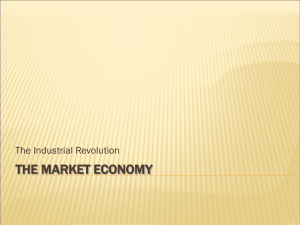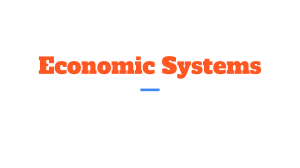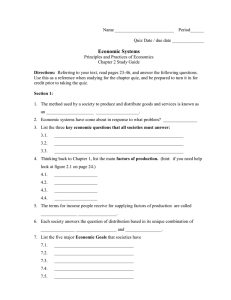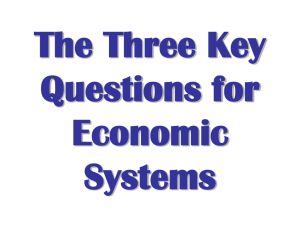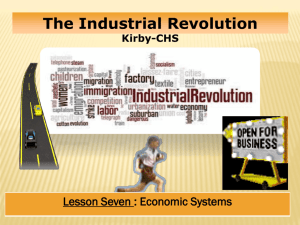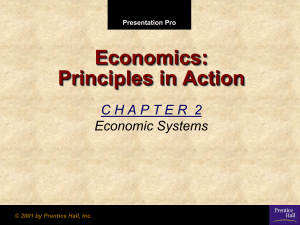Market Economy Notes
advertisement
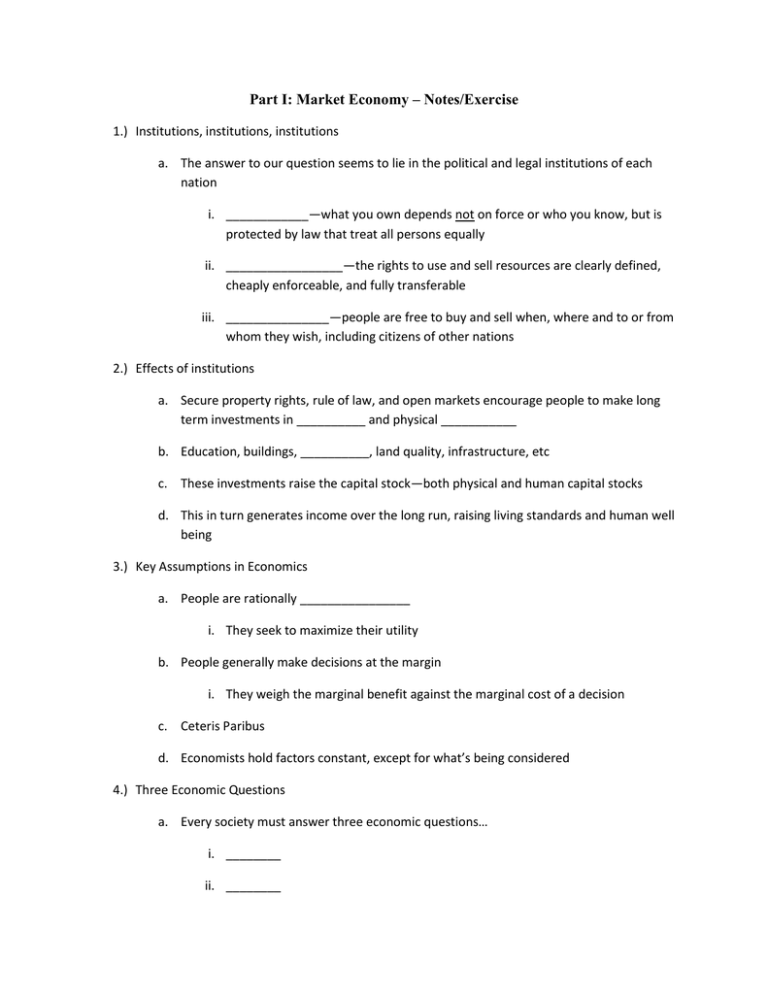
Part I: Market Economy – Notes/Exercise 1.) Institutions, institutions, institutions a. The answer to our question seems to lie in the political and legal institutions of each nation i. ____________—what you own depends not on force or who you know, but is protected by law that treat all persons equally ii. _________________—the rights to use and sell resources are clearly defined, cheaply enforceable, and fully transferable iii. _______________—people are free to buy and sell when, where and to or from whom they wish, including citizens of other nations 2.) Effects of institutions a. Secure property rights, rule of law, and open markets encourage people to make long term investments in __________ and physical ___________ b. Education, buildings, __________, land quality, infrastructure, etc c. These investments raise the capital stock—both physical and human capital stocks d. This in turn generates income over the long run, raising living standards and human well being 3.) Key Assumptions in Economics a. People are rationally ________________ i. They seek to maximize their utility b. People generally make decisions at the margin i. They weigh the marginal benefit against the marginal cost of a decision c. Ceteris Paribus d. Economists hold factors constant, except for what’s being considered 4.) Three Economic Questions a. Every society must answer three economic questions… i. ________ ii. ________ iii. __________ b. How that society answers the questions determines which type of economic system that society employs 5.) WHAT TO PRODUCE? a. WHAT goods and services will be produced with the available resources? 6.) Resources a.k.a. The Factors of Production a. Economists classify resources into 4 categories i. Land • ___________ resources • The payment for Land is RENT ii. Labor • ________________ • The payment for Labor is WAGES iii. Capital (a product of Investment) • Tools, __________, factories • The payment for Capital is INTEREST iv. Entrepreneurship • The special ability of risk-takers to combine land, • labor and capital in new ways in order to make profit • The payment for Entrepreneurship is PROFIT 7.) Check for Understanding a. At the top of a paper write Natural Resources , Human Resources and Capital Goods . Place these items under the correct heading. • Delivery Truck • Teacher • Factory • Tree • ATM machine • Bushel of corn • River • Hair stylist • Gold • Barrel of oil • Doctor • Farmer • Bulldozer • Tractor • Factory worker 8.) Answer Key a. Natural Resources iv. ___________ i. __________ v. ___________ ii. __________ iii. __________ c. Capital Goods iv. __________ i. _________ v. __________ ii. _________ b. Human Resources iii. _________ i. ___________ iv. _________ ii. ___________ v. _________ iii. ___________ 9.) HOW TO PRODUCE? a. HOW will the available resources be combined to produce goods and services? 10.) FOR WHOM TO PRODUCE? a. WHOM will be the consumer of the product or service? 11.) Three Economic Systems a. _________ Economies b. _________ Economies c. _________ Economies 12.) MARKET ECONOMIES a. Answer the key questions by a system of supply and demand. (in other words, it allows buyers and sellers to voluntarily exchange things) b. The ability of markets to coordinate economic activity is emphasized by Adam Smith in c. “The Wealth of Nations.” d. This is what he referred to as the Invisible Hand 13.) The Invisible Hand a. ...every individual necessarily labours to render the annual revenue of the society as great as he can. He generally, indeed, neither intends to promote the public interest, nor knows how much he is promoting it. By preferring the support of domestic to that of foreign industry, he intends only his own security; and by directing that industry in such a manner as its produce may be of the greatest value, he intends only his own gain, and he is in this, as in many other cases, led by an invisible hand to promote an end which was no part of his intention. Nor is it always the worse for the society that it was no part of it. By pursuing his own interest he frequently promotes that of the society more effectually than when he really intends to promote it. I have never known much good done by those who affected to trade for the public good. 14.) Invisible Hand a. What is Adam Smith basically saying with this passage? b. If individuals are allowed to pursue their own self-interest, then the often times the result will be a more efficient economy. There is NO PLANNING c. What do you think Adam Smith envisioned as the role of Government in the economy? 15.) COMMAND ECONOMIES a. Answer the key questions through a central authority made up of an individual or a number of individuals who make the decisions of what to make, how to make it, and for whom things should be made. (Self-Interest and Competition are absent) i. Communism ii. Socialism 16.) TRADITIONAL ECONOMIES a. Answer the key questions by relying on past customs and practices: b. “The Inuit of northern Canada serve as a prime example of a traditional economy. For thousands of years, the Inuit parents have taught their children the survival skills needed to survive in the Arctic Circle's severe climate. The children are taught to fish, hunt, and make effective tools. Once learned, these skills are passed down to the next generation.” 17.) Goals of Economic Systems a. Efficiency (maximize what you have) b. Freedom (ability to make choices) c. Security (goods/services will always be available) d. Equity (Fairness, Opportunity) e. Growth (Economy must grow with population; innovation) Part II: Peer Interview How much control should the government have? In this peer interview activity, you will be grouped with a fellow peer where you will be able to discuss and argue your opinion on this question: “How much control should the government have over society? Explain” I believe the government should have control over…. o 1.) o 2.) o 3.) I believe the government should not have control over…. o 1.) o 2.) o 3.) Part III: Practice - Economies Around the World Given the political spectrum (1 being full command economy, 10 being fully market economy), choose a country in the world (besides the United States) and research information about the country, answering the following questions: 1.) 2.) 3.) 4.) 5.) Where is the country located? (Geographic Theme #1, LOCATION!!) Describe the place? (What does the landscape look like? What are the people like?) What form of government exists in that country? How does the country answer the three economic questions? In your opinion, what number (1-10) would you give the country in terms of political spectrum
